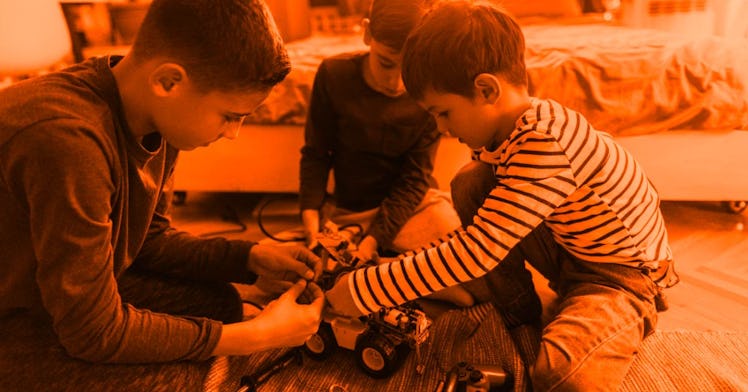5 Harsh Truths About STEM Toys
Parents might feel pressured to buy STEM toys to give their kids an edge, but they shouldn't buy it.

As children go back to school, STEM learning — the acronym stands for Science, Technology, Engineering, and Mathematics — will likely be on everyone’s mind. STEM is a big sell for schools trying to convince parents that they are preparing students for the science-heavy jobs of the future. But it’s also big business for toy companies that have been flocking to STEM as a marketing tool to capture results-oriented parents who’d like play to be as academically useful as it is fun.
But here’s the problem: While the popularity around STEM toys is skyrocketing, the research around their efficacy is lagging behind sales. So while toy companies are happy to promote a toy linked to Science, Technology, Engineering, and Mathematics, there’s little evidence to suggest the toy is good at teaching a child anything about those subjects. But that’s not the only harsh truth about STEM toys, requiring parents to be both more vigilant and thoughtful.
Toys Marketed as STEM-Oriented are Expensive
Toy manufacturers that differentiate their toys as being specialized for STEM can charge more for that specialization. Moreover, if a toy is app-enabled, uses artificial intelligence or is otherwise integrated to the internet or the cloud, manufacturers will ask a premium price for the cutting edge tech.
But there are plenty of toys and activities that help children learn concepts of mathematics and engineering. A good set of wooden blocks is a perfect example of a no-smart STEM toy rarely marketed as STEM. And not only are they more affordable than many high-tech STEM toys, but you also are never, ever, required to charge them or charge their batteries.
The Research on STEM Toys is Still Out
STEM toymakers claim that their devices will help kids learn coding or electrical engineering. Other’s claim to speed up the progress of math and science literacy. The problem is that there are no high-quality studies following a group of children who use such toys over a period of time that would lend credence to those claims. Until there is a large longitudinal study that looks at the educational outcomes for a large group of kids using STEM toys measured against a control group of kids who do not, then parents should be wary of STEM toy claims.
STEM Toys Are More About Employment Than Learning
A study by industry group The Toy Association found that 76 percent of parents wanted their child to end up in a STEM-related field as an engineer, doctor, web developer, or scientist. Additionally, parents felt that kids should be on their career path by five-and-a-half-year-old. Finally, nine out of 10 parents said that it was important for their kids to develop STEM skills.
These insights are incredibly problematic considering that childhood play should be about fun exploration more than it should be about career development. In fact, it’s highly unlikely that a child could even be oriented towards any career by preschool age.
Considering that so many STEM toys aim to teach kids coding, it’s clear that parents and toymakers are looking at career development rather than pure, imaginative, open-ended play. That’s not only unhelpful for kids, but it’s also simply impossible.
STEM Toys Are Built for Parents, Not Kids
Given that STEM Toys are geared for career development, the target of the toys isn’t necessarily children, despite the grinning kids on the packaging. Parents should remember that toys should be about fun and exploration. Open-ended and creative toys are often far more engaging than toys with a pedagogical purpose.
That doesn’t mean that open-ended creative toys can’t lead to learning. They absolutely can. And it also doesn’t mean that STEM toys can’t be incredibly fun for kids. The trick is to put the child first. Education comes with play when a kid is engaged and happy.
STEM Lessons Don’t Require High Tech Toys
STEM toys have been on the market for longer than the term has been a marketing tool. Legos, for instance, are STEM toys. If you want to go back further, you could easily call Lincoln Logs a STEM Toy and wooden blocks too. Even childhood game like Mother May I can teach fundamentals of coding with their process of if/then processes and contingencies. Throwing a ball and running through the woods can teach about physics and observing bugs under rocks can teach biology.
The fact is that children don’t need STEM toys. Parents shouldn’t feel pressured to buy them, or guilty for not spending the money on them.
This article was originally published on